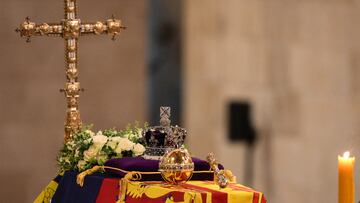Queen Elizabeth II’s casket: What is it made of and when was it made?
Queen Elizabeth’s coffin was built for a British monarch, the casket is made with materials designed to preserve her body and requires eight pallbearers.

Preparations for the death of Queen Elizabeth II have been ready for decades and her coffin, in which she travelled first from Balmoral to Edinburgh. And then onto London where she will lie in state until her funeral Monday 19 September.
Her Majesty’s casket is the similar to the one used for her late husband Prince Philip, the Duke of Edinburgh, who passed away last year, and made by the same specialist firm. The coffin was constructed in a similar fashion that has been used for members of the Royal Family and English nobility for over four centuries.
Also see:
What is Queen Elizabeth’s coffin made of?
The United Kingdoms longest-reigning monarch will be entombed in a coffin made of English oak with brass fitments and lined with lead. According to the Telegraph, it was originally built by the specialist firm Henry Smith over three decades ago. The records of the exact date that the casket was made were lost when Henry Smith was taken over by another firm in 2005.
Since its manufacture, it has been in storage under the care of two different firms who have been responsible for royal funerals. First JH Kenyon Ltd, which handled the funeral for Queen Elizabeth’s father King George VI in 1952, and then Leverton and Sons, which has had the responsibility since 1991. When Leverton and Sons took over care of the coffin the brass handles required replacement as it had already been in storage for an extended period of time prior.
The Coffin is really two-in-one, with the internal portion lead poured over a simple inner wood coffin. That is then placed inside the outer casket made of English oak, which in the case of royal coffins traditionally comes from the Sandringham estate. However, because the records of its construction were lost the source of the oak cannot be confirmed.

The combination of materials used to make Her Majesty’s coffin mean that it is much heavier than a normal coffin. It requires eight pallbearers, which will be from the Armed Forces, to carry it instead of the normal six.
Why Queen Elizabeth’s casket is lined with lead
The practice of encasing Royal Family members in lead coffins dates back hundreds of years at least to Queen Elizabeth I. Using lead allows the casket to be sealed, keeping out moisture and slows the decomposition process for up to a year longer than would normally occur.
Since lead doesn’t decay, the airtightness of the casket is not compromised which also keeps any smells and gases from escaping. Both qualities are important when interring a body above ground as will be the case with Queen Elizabeth II at her final resting place in the royal vault called King George VI Memorial Chapel.
Her husband Prince Philip’s casket will be moved from the Royal Vault beneath St George’s Chapel to lie next to her.






